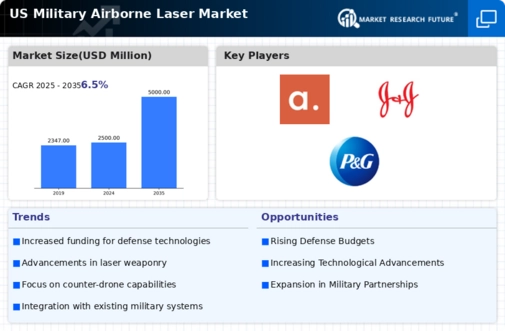Advancements in Laser Technology
Advancements in laser technology are significantly influencing the military airborne-laser market. Innovations in solid-state lasers and fiber lasers have led to increased efficiency, reduced size, and enhanced power output. These technological improvements enable the development of more effective airborne-laser systems capable of engaging a variety of targets. The military airborne-laser market is expected to experience growth as these advancements allow for more versatile applications, including air defense and precision strikes. The U.S. military's commitment to research and development in this area is reflected in a projected investment of $1.5 billion over the next three years.
Increased Focus on Energy Efficiency
The military airborne-laser market is also driven by an increased focus on energy efficiency. As military operations become more complex, the need for sustainable and cost-effective solutions is paramount. Airborne lasers offer a unique advantage, as they can provide precision strikes without the logistical challenges associated with traditional munitions. This shift towards energy-efficient systems aligns with the U.S. military's broader strategy to reduce operational costs and environmental impact. The military airborne-laser market is likely to see a rise in demand as energy-efficient technologies become integral to future defense strategies.
Emerging Threats and Geopolitical Tensions
The military airborne-laser market is increasingly driven by emerging threats and geopolitical tensions. As nations face evolving security challenges, the demand for advanced defense systems rises. The U.S. military recognizes the necessity of maintaining technological superiority, particularly in the face of adversaries developing sophisticated weaponry. This has led to a projected increase in defense budgets, with allocations for directed energy systems, including airborne lasers, expected to rise by approximately 15% over the next five years. The military airborne-laser market is thus positioned to benefit from heightened investments aimed at countering these threats.
Growing Interest in Non-Lethal Applications
The growing interest in non-lethal applications of airborne lasers is emerging as a significant driver for the military airborne-laser market. As military operations increasingly prioritize minimizing collateral damage, the potential for lasers to incapacitate rather than destroy is gaining traction. This shift is particularly relevant in urban warfare scenarios, where precision and restraint are critical. The military airborne-laser market is expected to expand as the U.S. military explores non-lethal options, with funding for research into these applications projected to reach $500 million in the next fiscal year.
Integration with Existing Military Platforms
The integration of airborne-laser systems with existing military platforms is a crucial driver for the military airborne-laser market. As the U.S. military seeks to enhance the capabilities of its aircraft, the incorporation of laser systems into fighter jets and drones is becoming more prevalent. This integration not only improves operational efficiency but also reduces costs associated with developing new platforms. The military airborne-laser market is likely to see a surge in demand as the U.S. Department of Defense prioritizes modernization efforts, with an estimated $2 billion earmarked for laser technology integration in the upcoming fiscal year.














Leave a Comment